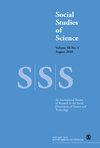地图基础设施:地理病理学,肿瘤之旅和英属东非的殖民网络
IF 2.7
2区 社会学
Q1 HISTORY & PHILOSOPHY OF SCIENCE
引用次数: 0
摘要
在本文中,我们将探索基础设施——人类、认知和材料——这些基础设施使地图的创作和它们所讲述的世界故事成为可能。我们发展了“地图基础设施”的概念,以揭示隐藏和脆弱的政治、科学和社会世界,这些世界支撑着地图的制作和它们带来的真相。为了说明这一点,我们研究了丹尼斯·伯基特(Denis burkitt)——一位在英属东非工作的殖民地医生——在20世纪60年代早期出版的一系列极具影响力的地图,这些地图显示了非洲儿童肿瘤的地理分布。通过将肿瘤与海拔和降雨量联系起来,这些地图表明它起源于病毒,这一发现深刻地影响了癌症研究,并帮助加速了病毒肿瘤学的发展。利用伯基特和其他人留下的报告、日记和照片,我们挖掘了支撑他的地图和病毒假说的制图基础设施。首先,我们考察了地理病理学的研究传统——其重点是致癌的环境因素及其对非洲作为癌症研究实验室的兴趣——是如何为伯基特提供开展工作所需的理论、网络和资金的。其次,我们考察了监视实践,从肿瘤狩猎到地理绘图,这使得Burkitt能够生成和解释他的地图背后的数据。第三,我们分析了遍布非洲的白人殖民医疗官员和传教士医生的社区,他们对种族、帝国和冒险的共同想象是伯基特进行调查所依赖的。本文章由计算机程序翻译,如有差异,请以英文原文为准。
Cartographic infrastructures: Geographical pathology, tumour safaris, and colonial networks in British East Africa
In this article, we explore infrastructures—human, epistemic, and material—that enable the creation of maps and the stories they tell about the world. We develop the concept of ‘cartographic infrastructures’ to reveal the hidden and fragile political, scientific, and social worlds that undergird the production of maps and the truths they bring into being. To illustrate this, we examine a series of highly influential maps published in the early 1960s by Denis Burkitt—a colonial doctor working in British East Africa—showing the geographical distribution of a pediatric tumour in Africa. By correlating the tumour with altitude and rainfall, the maps suggested it had a viral origin, a finding that profoundly affected cancer research and helped accelerate the development of viral oncology. Using reports, diaries, and photos left behind by Burkitt and others, we excavate the cartographic infrastructures that underpinned his maps and viral hypothesis. First, we examine how the research tradition of geographical pathology—with its focus on environmental factors in carcinogenesis and its interest in Africa as a laboratory for cancer research—provided Burkitt with the theories, networks, and funding necessary to conduct his work. Second, we examine the surveillance practices, ranging from tumour safaris to geographical plotting, that enabled Burkitt to generate and interpret the data underlying his maps. Third, we analyze the communities of white colonial medical officers and missionary doctors spread across Africa with their shared imaginaries of race, empire, and adventure on which Burkitt relied to conduct his surveys.
求助全文
通过发布文献求助,成功后即可免费获取论文全文。
去求助
来源期刊

Social Studies of Science
管理科学-科学史与科学哲学
CiteScore
5.70
自引率
6.70%
发文量
45
审稿时长
>12 weeks
期刊介绍:
Social Studies of Science is an international peer reviewed journal that encourages submissions of original research on science, technology and medicine. The journal is multidisciplinary, publishing work from a range of fields including: political science, sociology, economics, history, philosophy, psychology social anthropology, legal and educational disciplines. This journal is a member of the Committee on Publication Ethics (COPE)
 求助内容:
求助内容: 应助结果提醒方式:
应助结果提醒方式:


